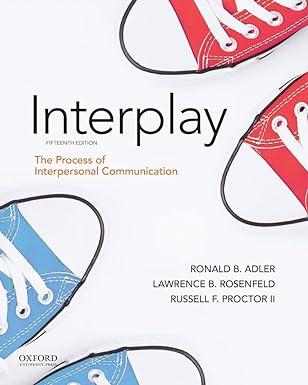Answered step by step
Verified Expert Solution
Question
1 Approved Answer
Communication is important when I take reports from citizens at my workplace. I prefer to do this verbally face - to - face, but I
Communication is important when I take reports from citizens at my workplace. I prefer to do this verbally facetoface, but I do also combine nonverbal communication to enhance our conversation. I combine them because I want the person to see that I am empathetic to their situation and show them that I understand what they want for a solution. If a solution cannot be found, I want them to understand why. On the other hand, I want to read their body language because I can see if they are presenting the appropriate expressions to match their situation, I can clarify if they leave out key details in their story, I can ensure they are not under the influence which all of these help me determine if they are being truthful with me Unfortunately, they are not always. An example would be a person who walks into my workplace and is visibly upset. Their face is red, their eyes are open wide, and their voice sounds as if they want to yell what they have to tell me but they are attempting to calm themselves. I immediately know by their body language that they are angry, they believe they were wronged, and they are expecting me to agree with them or they will lose their faith in my authority. I know that I need to listen, appear sympathetic to their situation, and explain to them exactly what I can and cannot do and why. I often take reports like this for road rage incidents. The incident usually happened moments before they come to the station, and they are the only witness. There is not much I can do legally to help this person, so I must explain why. This is where my verbal skills and being selfaware of my body language is important because if I simply shrug and say Sorry I cannot do anything. That citizen is not going to think I care and will assume I just do not want to help them. By explaining with an empathetic tone and facial expressions. I can explain in detail what I can do and then why I cannot do what they want me to do Usually, they will calm down and realize that if the situation occurs again, they can do more to gather information or respond to it in a different way. They may not leave satisfied, but at least I have answered all their questions, and they can move on with their day.
Of the communication strategies shared, what would be the most appropriate strategy for the situation that was discussed? Provide additional strategies or insights that could help your peer improve the strategies they shared.
Based on the situation your peer shared in their post, what other communication strategies could be used in a similar situation in the future, and why do you think these would be helpful?
Based on the situation your peer shared in their post, how could these communication strategies be used?
Step by Step Solution
There are 3 Steps involved in it
Step: 1
1 The most appropriate communication strategy for the situation described would be active listening combined with empathetic verbal and nonverbal comm...
Get Instant Access to Expert-Tailored Solutions
See step-by-step solutions with expert insights and AI powered tools for academic success
Step: 2

Step: 3

Ace Your Homework with AI
Get the answers you need in no time with our AI-driven, step-by-step assistance
Get Started


